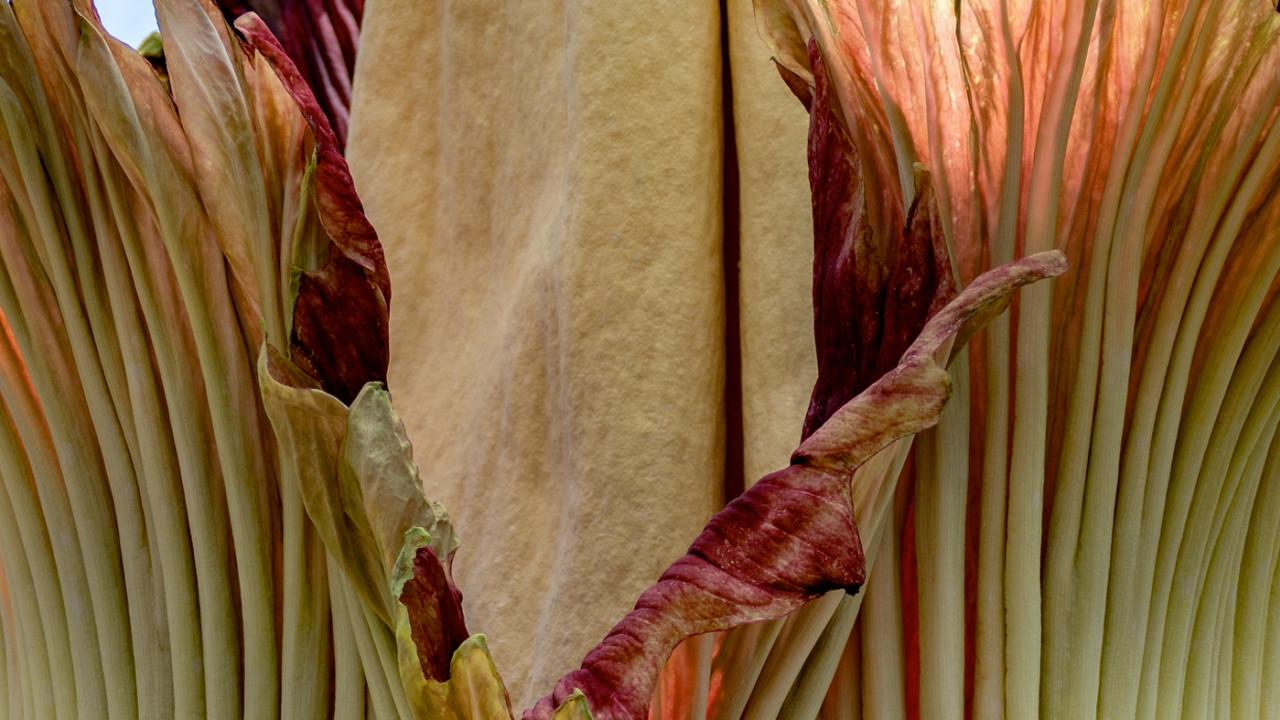
Titan Arum—FAQ
Frequently Asked Questions
About the Titan Arum (Amorphophallus titanum)
In 1878, an Italian botanist named Odoardo Beccari “discovered” the titan arum in the dense equatorial rainforests of the island of Sumatra. Although the tubers that he sent to Florence died, some seeds survived, and a single seedling was sent to the Royal Botanic Gardens, Kew. It flowered in 1889. But only recently has the horticulture world had success in raising the corpse flower in cultivation.
In August 2015, more than 75,000 people visited Spike, the Garden's first corpse flower to begin its bloom cycle. Spike ultimately did not have the energy to open. Alice the Amorphophallus bloomed in September 2015, and Sprout bloomed in April 2016. Java, our biggest titan arum ever at nearly 7 feet tall, bloomed in May 2017. Since then, Sumatra, Sunshine, Alice, and Spike have bloomed.
Q. The Garden has had several corpse flowers that had the potential to bloom in the last few years. What makes it a rare event?
A. It takes seven to ten years for a single corpse flower to gather enough energy to begin its bloom cycle. The Garden began collecting titan arums in 2003, as part of a worldwide conservation effort to preserve the species. The Garden received several of its titan arums at the same time, which is why the Garden has had several corpse flowers ready to bloom in recent years. It is a rare event when a corpse flower is in full bloom.
Q. How do you know when the bud is going to bloom?
A. There are three main clues we look for when determining the peak bloom. First, as the arum “powers up” its bloom cycle, it grows several inches per day. When the titan arum gets ready to open, that growth rate slows noticeably. Second, the two protective modified leaves (called bracts) that encircle the base of the spathe begin to shrivel and dry up. In the days before full bloom, they fall off—first one, then the other. That’s a sign that the bloom is likely to happen. Finally, the frilly leaf called a spathe—which was tightly wound around the towering spadix as it shot up—starts to loosen its grip as bloom time nears, revealing the crazy-beautiful maroon color inside. Once the spathe begins to loosen, a bloom is imminent. It's really not an exact science, but these clues give us a general time frame for the bloom.
Q: How long does the plant bloom?
A. The plant generally blooms for 24 to 36 hours. After the spathe opens fully, the bloom usually lasts until the following afternoon, or in some cases, the following morning.
Q. How frequently does it bloom?
A. When a corm (an underground giant tuber) is grown from seed, it can take a while to reach the size necessary to support a bloom, usually about ten years. Once the plant has bloomed, however, the corm is already at a size to support another bloom, so it may take only three to seven years before it stores up enough energy to bloom again—or may rebloom much sooner, every two to three years.
Q: How big does this plant really get?
A: We have heard tales of some titan arums in their natural habitats growing 10 to 12 feet tall with a bloom diameter of up to 5 feet, but more typically in cultivation, an arum reaches 6 to 8 feet in height before the spathe unfurls into a bloom, with a diameter close to 3 feet.
While it looks like a 6- to 8-foot-tall flower, the titan arum's bloom is not really a flower: Technically, the bloom is the largest unbranched inflorescence in the world. The tall spadix (flower spike) is wrapped by a spathe (a single, frilly, modified leaf). In its vegetative form, each Amorphophallus titanum looks like a small tree, but is actually a single umbrella-like leaf. The leaf stalk is called the petiole, and is covered in branch-like rachis, supporting the many leaflets. Titan arum leaves can grow 8 to 15 feet tall.
Q. Did the Garden grow these plants from seed or buy the corms? Where did the Garden get them?
A. The Garden's titan arums came from a variety of sources, mostly as small corms. Java and Sumatra are from the same plant parent as Sprout, which was acquired from the University of California Botanical Garden at Berkeley in 2008 and grown from seed. Retailers can be found online, but home cultivation is discouraged. Because the habitat for the plant is being deforested, it is unknown how common this plant is in the wild. The corm is also harvested for its starch in its native habitat of Indonesia. One corm can weigh 200 pounds—a valuable, if possibly dwindling, food source.
Q. How endangered are the corpse flowers?
A. The corpse flower is considered "vulnerable" when it comes to its conservation status. A vulnerable species is considered as such because it's likely to become endangered unless the circumstances threatening its survival and reproduction improve. Vulnerability is mainly caused by habitat loss or destruction. There are currently 4,914 plants classified as vulnerable, compared to 2,815 in 1998.
Q. Will this plant bloom die after blooming?
A. Unlike the spectacular (and similarly long-awaited bloomer) the century plant, or Agave americana, blooming is not the end of the life cycle for the titan arum. If pollinated, it will produce fruit for the next nine months or so. Once the fruit is ripe, it will die back, and after a year or so of dormancy, will emerge as a leaf for the next few cycles until it is ready to bloom again.
Q. What does it look like when it's not flowering?
A. Most of the non-flowering titan arums in our collection are simply too large and heavy to move on display, and take up quite a bit of space. Each leaf (while they look like trees, each plant structure is botanically a single, enormous leaf) can grow to 15 feet tall, and the corms supporting each leaf are quite large and heavy. We don't wish to cause any damage to these rare plants by moving them from their comfortable and airy location in our production greenhouses.
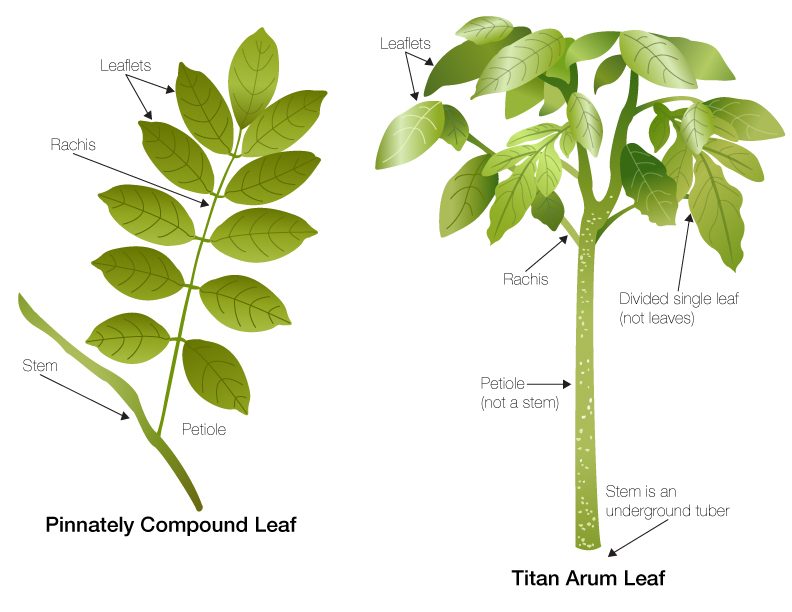
Q. What is that awful smell, and why does it make that awful smell?
A. That smell is the reason it’s called the corpse flower. Chemically, the scent is a combination of dimethyl trisulfide, isovaleric acid, dimethyl disulfide, benzyl alcohol, indole, and trimethylamine—or, as our friends at the Huntington Botanical Gardens described it, a combination of Limburger cheese, garlic, rotting fish, and smelly feet. The plant is trying hard to attract its native Sumatran pollinators: carrion beetles and flesh flies that are attracted to the stench of decaying, rotten meat (the kind of place they’d want to lay their eggs). The precise combination of odors is meant to mimic an exact state of decomposition—something that is not fresh, but not so rotten that it is no longer attractive.
Q. Is the smell very bad? Will we feel sick smelling the plant?
A. The scent lasts for a few hours, and is often strongest in the wee hours of the morning. The odor is produced by the spadix, and can be detected by pollinators up to an acre away, but is not overpowering—our volunteers (and visitors) will be grossed out by it, but it's unlikely anyone will become physically ill. By daybreak, it begins to dissipate, as the 450 to 5,000 male flowers (in a ring above the female flowers) open, releasing the pollen that covers the unsuspecting insects that have gathered during the night.
Q. Why do most bloom at night?
A. That’s when carrion beetles and flesh flies are active and crawling about. It's possible that night breezes could also factor in—carrying the scent farther into the canopy at night. Inside the tightly wrapped spathe, the plant uses stored energy from the corm to heat up internally to more than 90 degrees Fahrenheit. The area of the spadix that is smelly, the appendix, is above all of the flowers (male and female) and is the part that sticks out of the spathe before it opens. Some scientists hypothesize that when the spadix heats up, the rising heat acts to draw the air up from below. This convection of smelly air above the plant then spreads the scent though the forest into the canopy, towards pollinators.
Q. What do you do with the pollen made by the male flowers?
A. Roughly 12 hours after the female flowers have been pollinated and the top of the spadix cools, the male flowers (which also heat up during the process) begin exuding long strands of pollen. In the case of Alice the Amorphophallus, when the male flowers reached 82.6 degrees Fahrenheit, they began to exude pollen. About two hours after pollen production began, we used tools to collect the pollen and place it in containers to freeze for storage. Some of the pollen will be banked here at the Garden, and some will be sent to other institutions to pollinate their titan arums. A small amount is kept for research into the structure of the grains, and to research precisely how pollination works in these amazing plants.
Q. What do the seeds look like? Will you leave the plant on display while they grow?
A. If a titan arum is lucky enough to be pollinated, it will develop a seed cylinder within the slumped-over remains of the flower. The fruits are olive-shaped, red-orange berries, much prized by rhinoceros hornbills, which feast on them, thus spreading the seeds around their native rainforest habitat. Without rhinocerous hornbills in our Greenhouses, the fruits will be left to mature, but that can take some time. Yellow fruit starts to form four to seven or more weeks after pollination, and continues to ripen for several more months. Roughly nine months after pollination, the fruit has darkened to a bright red and is ready to be harvested. The seed of the fruit can be planted to produce a new corm. The length of time involved in the seeds growing to maturity means that our titan arums will return to the production greenhouses once their blooming cycles are complete.
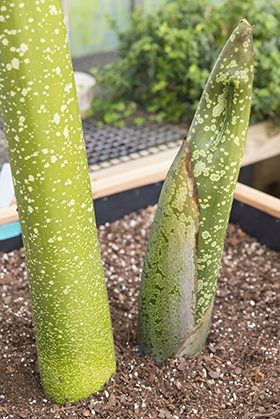
An Amorphophallus titanum bud and a leaf stalk show the difference in appearance between a leaf and a bud.
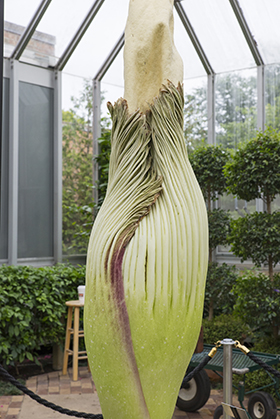
A titan arum bud looks ready to open—the spathe will open soon, revealing the crimson interior, and a distinctive odor.
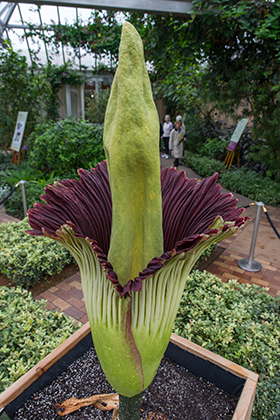
Alice the Amorphophallus in full bloom in the early morning of September 29, 2015

Titan arum leaves in various stages of growth and dormancy line the wall of the Production Greenhouse.
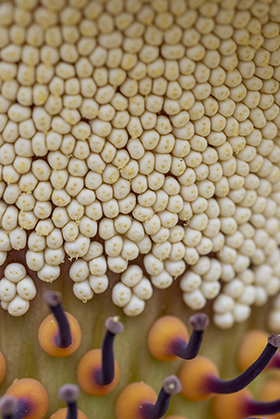
The male (top) and female (bottom) flowers inside the titan arum's tightly wrapped spathe. The male flowers have just started exuding pollen.

